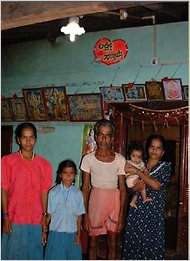From Lenin to Franklin Delano Roosevelt, 20th-century political leaders made the provision of universal electricity a centerpiece of their programs and oratory. "Communism is Soviet power plus the electrification of the whole country," one slogan went. Or, in the case of F.D.R.'s Tennessee Valley Authority, "T.V.A.: Electricity For All."

SelcoA rural family in southern India with a solar-powered light fixture.
In this century, the United Nations has updated the concept in addressing the problem that 1.4 billion people in the world are living without electricity. The new buzz phrase is "Sustainable Energy For All," but the approach is very different, because in many cases these people cannot be connected to a grid. Given that the vast majority of the unconnected live near the equator, where the sun is at its zenith, the solutions being tried are almost all based on solar power.
One of the chief proselytizers is Richenda Van Leeuwen, who oversees the energy-access efforts of the United Nations Foundation, a philanthropic organization that works to support many of the United Nations' humanitarian efforts. Like a Hollywood producer trying to bring together a script, a director, some actors and some financial angels, she spends her waking hours trying to assemble packages of financial resources, new technologies and new payment practices and to pinpoint willing recipients of the products.
"There are so many different targeted applications to help people solve problems on a daily basis," she said in an interview — things like a solar-powered lantern that an Indian midwife can hang above the bed so that both of her hands are free, for example. Or the desk lamps made by the San Francisco-based company d.Light Design. Or solar-powered drip irrigation systems being used in Benin and India, or solar-powered lights for voting booths in the Democratic Republic of Congo.
Ms. Van Leeuwen's goal is to provide emerging companies making these technologies with access to funds from socially conscious investors who are willing to tolerate higher risks and less financial reward. First she seeks to ensure that the price of the products is within the reach of the people who will be using them. Then there is a need for a supply chain that can distribute the devices, and a support system that ensures that there are spare parts and local people who can do repairs.
A lot of this would not have been as possible a decade or two ago, when solar power technologies were less robust and electrical lighting usually required energy-hungry incandescent bulbs. Now, Ms. Van Leeuwen said, advances in light-emitting diodes, which provide more light with less energy, and in small-scale solar power technology are spawning a new generation of devices for people who lack access to a grid.
The effort evokes the spread of cellular phones, swiftly adopted in places around the world that had no land lines. Ms. Van Leeuwen cited a recent prediction by the United Nations publication World Energy Outlook that said that if the goal of 100 percent access by 2030 was achieved, 70 percent of those with new access would get it either through a miniature grid or off-grid devices like those mentioned above.
If the prices of the new devices can be scaled to their means, these people will form a significant potential market. "If you can get a cellphone in the remotest village," Ms. Van Leeuven said, "you can get a small-scale energy solution, too."
In 2010, she pointed out, more money was invested in renewable energy in the developing world (mostly China) than in the developed world.





